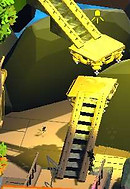
GAMES
Grammatical Nonsense (Tabletop)
Presented at World Maker Faire and the Come Out & Play Festival



Grammatical Nonsense is an evidence-based storytelling game designed to support language, literacy, and social skills development for kids who struggle with every challenges. I independently wrote, designed, and illustrated over 500 cards for Grammatical Nonsense, with three years of playtesting around the country before the game was crowdfunded in August, 2021.

Grammatical Nonsense is played in 3 countries, 29 states, and 48 classrooms, as well as in numerous specialty learning environments for students with disabilities, such as schools for the deaf and hard of hearing. Add-ons are available, along with custom lesson plans and game rules, to support ESL, speech-language pathology, math, and other learning needs.

Card Features
-
Extra spacing between letters to support readers with dyslexia.
-
Color-coding and pattern recognition to support players with short-term memory, attention, executive functioning, and pragmatic challenges.
-
Signaling and iconographic cues for nouns and strong emotions.
-
Stylized word families for players to quickly identify essential part-of-speech pairings even when struggling with early reading skills.
-
Dozens of structured games for classroom, speech-language pathology, and home play.
-
Simple language and sans-serif typefaces to support learners who are new to English or who struggle with basic reading skills.
-
Emotion regulation and conflict & resolution words to support players struggling with emotion regulation and identification.
-
Carefully chosen vocabulary to provide a streamlined and clean experience for early readers, while including essential practice words for speech-language pathology.
-
Easy-shuffle texturing ("linen texturing") and thickness (330gsm) are used to support players who struggle with manual dexterity.
-
Water-resistant and UV-resistant coatings are used so that players can use the cards anywhere and anytime.
Junker & The Sunken City (C#, JavaScript, Unity 3D)
Supported by the Horn Family Fund for Environmental Research
(Awards received for 2017, 2018, and 2019)
A zero-combat survival and adventure role-playing game about material science and the power of recycling, reusing, and reducing. Players are expected, by the game’s completion, to understand where and how to recycle and reuse basic everyday objects and materials, such as printer paper, glass bottles, or soup cans. Specifically, players should understand how paper, plastic, metal, glass, and organic materials are properly disposed of, broken down, and reused. Players are also expected to develop higher-level social, conceptual, and visualization skills, consistent with Gee’s theories on learning and knowledge acquisition in virtual worlds (Gee, 2008).





Mars Colony Quest (Immersive Role-Playing)
Presented and played at the New York Hall of Science, 2019
A museum-wide adventure game in which kids and parents took the roles of engineers, mechanics, astrophysicists, designers, and climate scientists as they plan for a new human colony on Mars.
During the game, players accepted their roles from Mission HQ and were provided with special badges describing their roles. After accepting their quests, they went on a treasure hunt throughout the New York Hall of Science to find and complete mission-specific tasks while learning about new science subjects from museum staff.
Every quest was different, and some required players to build, draw, or design using provided materials. After completing quests, players returned to Mission HQ and received stickers that they affixed to their badges to show that they completed the requirements of their roles. They were then able to take on new roles and explore new parts of the museum with their families.



Habitat (Tabletop)


Played at New York PS 118
A kindergarten tile matching game in which players are given colored grid boards and race to flip over and match the tiles to place animals in the appropriate habitats. Players roll a large dice with animals imprinted to determine which animals will be matched each round.
Hamster Dash (C#, JavaScript, Unity 3D)
Presented at NYU Game Center
A narrative arcade and puzzle game in which players take on the role of a hamster that is trying to escape its uncaring owner. Caught inside his hamster ball, the player rolls through obstacles in ever-more-difficult levels, catching treats to increase speed.
Like more traditional arcade games, levels are timed and points are accrued by the acquisition of special items within the game world. In future renditions of this game, thematic apartment items may be included to replicate the home space.




Motion Impossible (PowerPoint)
Presented at NYU Game Center
A physics game for middle-schoolers in which the player is tasked with flying a ship to intercept a comet before it hits earth. Along the way, the player must manage fuel, make choices that determine future game behaviors, and adhere to gravitational concepts to progress through levels.
The game also includes several unique celestial bodies to showcase how gravity and physics work differently in different scenarios. For example, the player must navigate stars, galaxies, asteroid fields, and planets of different types.




Aquatic Snake (OpenProcessing)



Presented at NYU Game Center
A simple game of snake with a twist. In Aquatic Snake, the player navigates and avoids dangerous bubbles, which obscure the tail of the snake when it has reached a certain length. The player must then recall and visualize the snake's length when it is not visible. Randomized death statements are projected at the end of each round.
